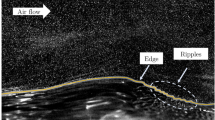Abstract
We present a scheme for parameterising scalar transfer in the urban boundary layer, which is divided into an inertial layer and a roughness layer. The latter is further divided into a shear layer and a canyon layer. In the inertial layer, scalar transfer is determined by turbulence related to canyon macroscopic features, while in the roughness layer, it is determined by shear-generated turbulence, canyon vortex and vortex-generated turbulence. We first describe a conceptual model for the canyon flow and the aerodynamic resistance network, and then estimate the resistances from the point of view of drag partition and vortex advection. The results are compared with the measurements from wind-tunnel experiments. It is found that for small canyon aspect ratio, σc, the transfer velocity increases with σc, reaching a maximum at around σc=0.5 and then decreases with σc. We also show that the scheme is not sensitive to adjustable parameters
Similar content being viewed by others
References
Barlow J.F., Belcher S.E. (2002). ‘A Wind Tunnel Model for Quantifying Fluxes in the Urban Boundary layer’. Boundary-Layer Meteorol. 104:131–150
Barlow J.F. Harman I.N., Belcher S.E. (2004). ‘Scalar Fluxes from Urban Street Canyons. Part I: Laboratory Simulation’. Boundary-Layer Meteorol. 113:369–385
Cheng H., Castro I.P. (2002). ‘Near Wall Flow over an Unban-like Roughness’. Boundary-Layer Meteorol. 104:229–259
Depaul F.T., Sheih C.M. (1984) ‘A Study of Pollutant Dispersion in an Urban Street Canyon’. Argonne National Laboratory Technical Report ANL/ER-84-1:84
Depaul F.T., Sheih C.M. (1986). ‘Measurements of Wind Velocities in a Street Canyon’. Atmos. Environ. 20:455–459
Garratt J.R. (1980). ‘Surface Influence Upon Vertical Profiles in the Atmospheric Near Surface Layer’. Quart. J. Roy. Meteorol. Soc. 106:803–819
Harman I.N., Barlow J.F., Belcher S.E. (2004). ‘Scalar Fluxes from Urban Street Canyons. Part II: Modelling Study’. Boundary-Layer Meteorol. 113:387–410
Hoydysh W.G., Dabberdt W.F. (1988), ‘Kinetics and Dispersion Characteristics of Flows in Asymmetric Street Canyons’. Atmos. Environ. 22:2677–2689
Kastner-Klein P., Plate E.J. (1999). ‘Wind-Tunnel Study of Concentration Fields in Street Canyons’. Atmos. Environ. 33: 3973–3979
Louka P., Belcher S.E., Harrison R.G. (2000). ‘Coupling Between Air Flows in Streets and the Well-developed Boundary Layer Aloft’. Atmos. Environ. 34, 2613–2621
Macdonald R.W., Griffiths R.F., Hall D.J. (1998). ‘An Improved Method for the Estimation of Surface Roughness of Obstacle Arrays’. Atmos. Environ. 32:3845–3862
Marshall J.K. (1971). ‘Drag Measurements in Roughness Arrays of Varying Density and Distribution’. Agric. Meteorol. 8: 269–292
Nakamura Y., Oke T.R. (1988). ‘Wind, Temperature and Satbility Conditions in an East-west Oriented Urban Canyon’. Atmos. Environ. 22:2691–2700
Oke T.R. (1988). Boundary Layer Climates. Methuen, New York, 435 pp
Raupach M.R. (1992). ‘Drag and Drag Partition on Rough Surfaces’. Boundary-Layer Meteorol. 60:374–396
Rotach M. (1995). ‘Profiles of Turbulence Statistics in and Above an Urban Street Canyon’. Atmos. Environ. 29:1473–1486
Shao Y., Yang Y. (2005). ‘A Scheme for Drag Partition over Rough Surfaces’. Atmos. Environ. doi: 10.1016/j.atmosenu.2005.09.014
Author information
Authors and Affiliations
Corresponding author
Rights and permissions
About this article
Cite this article
Yang, Y., Shao, Y. A Scheme for Scalar Exchange in the Urban Boundary Layer. Boundary-Layer Meteorol 120, 111–132 (2006). https://doi.org/10.1007/s10546-005-9033-5
Received:
Published:
Issue Date:
DOI: https://doi.org/10.1007/s10546-005-9033-5




